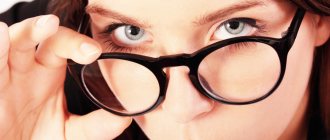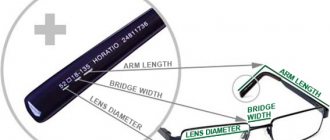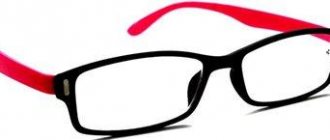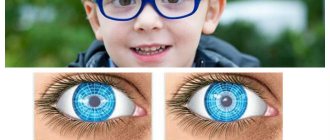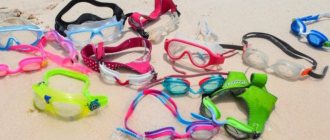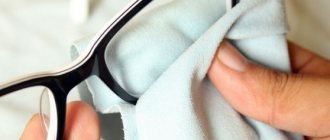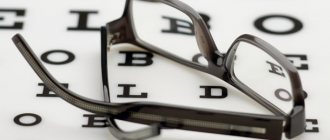One of the most important areas of modern ophthalmology is timely spectacle correction in patients with refractive errors. It allows you to maintain full vision and provide maximum visual comfort. Optical correction of ametropia allows minimizing disturbances in binocular vision, maladaptation of visual perception, and other ophthalmological pathologies.
Choosing glasses depending on your face shape
If you suspect deviations in refraction, you should immediately visit an ophthalmologist.
He will conduct a detailed diagnosis, determine the diagnosis and advise which product to buy. Visual acuity testing is usually carried out using the Sivtsev table. It is a large poster with letters of the Russian alphabet on it. The lower the line of characters, the smaller the font. The patient is positioned at a distance of five meters from the table. Each eye is checked in turn. With one eye closed, name the letters that the ophthalmologist points to. This is a fast and effective method for determining the optical characteristics of the organ of vision.
If eye acuity differs from unity, a second test is carried out, but using a corrective lens. The doctor sequentially selects the eyepiece first for the left eye, then for the right eye. The final stage of the procedure is a vision test. The indicator in the lenses must be within one.
To obtain accurate data, it is additionally possible to conduct an examination of the fundus and computer diagnostics of refraction, which will help to detect pathological processes in the visual apparatus. Based on the test results, you can choose lenses more correctly to achieve maximum therapeutic effect.
Visual acuity in the left and right eyes is not always identical. Such situations require a more thorough examination. In order not to make a mistake with the choice of lenses, you will first need an eyepiece for one eye, then for the other. To do this, the patient closes the right (left) eye and the doctor adjusts the optics until vision reaches maximum acuity. Then the manipulations are repeated with the second eye.
If the deviation is insignificant, it is allowed to use the same eyepieces. In this case, the ophthalmologist relies on the patient’s personal feelings. The product should not cause discomfort or pain.
If the difference is significant, then a complex recipe is drawn up, in which the parameters for each eye are indicated through a line. In such situations, ready-made glasses sold in optical stores will not be suitable. It is necessary to order the creation of an individual model in accordance with the indicators indicated in the recipe.
| Differences in visual acuity may signal the development of ophthalmic pathologies, for example, glaucoma, cataracts, retinal detachment. |
The most important thing when buying corrective optics is to choose the right eyepieces. Yes, the doctor prescribes the basic parameters in the prescription. But everything else falls on the shoulders (or bridge of the nose) of the future owner of the glasses. Experienced employees of specialized salons will help you make your choice.
They will talk about the advantages and disadvantages of a particular model. When choosing optics, it is important to pay attention to the manufacturer, frame material, appearance, type of lens coating, and refractive index.
Corrective optics not only help correct existing vision problems, but are also a stylish accessory. With their help, you can create a unique image and emphasize your individuality. For this reason, it is extremely important to know how to choose glasses based on your facial structure.
There are several types of human “face”:
- Square. Oval and rounded frames look good;
- Round face. Strict glasses in a square frame will look great. In this case, the shade of the frame must be chosen in a saturated color so that it stands out clearly on the face;
- Oval type. The lucky owners of such a face can choose any model, everything looks good on them. The only limitation is that you should not buy glasses that are too bulky;
- Heart-shaped look. A universal face type that is also suitable for all models. However, there is a small recommendation for choosing frames: choose products with a minimum number of decorative elements;
- Elongated shape. For such a face, all optical models with large frames and lenses are well suited. It is better to immediately put aside narrow and miniature options.
Myopia is a pathology that causes difficulties with distant vision. The patient cannot clearly distinguish objects located at a great distance. At the same time, there are no problems with near vision. Usually the disease develops as a result of overstrain of the eye muscles, with a genetic predisposition.
Depending on the degree of deviation from the norm, the doctor will recommend wearing the product constantly or using it only for working at a PC. The second case is relevant for patients whose degree of refractive error does not exceed minus one.
When choosing “myopic” glasses, adhere to the following recommendations:
- The frame is selected depending on visual acuity. If the diopters are high, then it is better to go with a wide frame. This model will completely cover the edges of a thick lens and ensure reliable fixation in the frame;
- If low or moderate myopia is detected, purchase semi-rimless frames or other shapes that suit your face type;
- Lenses for correcting myopia are made from thin glass or plastic. They are thin in the center and thicker at the edges. Such optics visually make the eyes smaller.
Corrective glasses are not just a fashion accessory; they are used to correct refractive errors and restore visual acuity. If visometry is performed incorrectly or the eyepieces are selected incorrectly, the product can cause serious harm to health. Therefore, only an ophthalmologist can prepare a prescription for the purchase of optics.
| If the eyepieces are selected incorrectly, the patient complains of rapid eye fatigue, severe fatigue, decreased visual acuity and deterioration in general well-being. Negative symptoms may not appear immediately, but accumulate over a long time. |
Due to an erroneous selection of glasses, a person faces the following consequences:
- Constant headache;
- Nausea;
- Declining level of performance;
- Problems with visual acuity;
- Unstable emotional state.
If at least one of the listed symptoms occurs while wearing optics, immediately contact the clinic and undergo a repeat eye acuity test.
Choosing for myopia
Myopia is a disease in which the patient complains of problems with distance vision. He cannot see clear outlines of objects at a great distance. At the same time, he distinguishes objects well close up.
In most cases, myopia occurs as a result of increased tension in the eye muscles, reading in poor lighting, or in the presence of heredity.
Depending on the diopter value, the doctor may prescribe glasses for constant use or only for reading and computer work. Wearing glasses intermittently is indicated for those with vision no more than -1.
The choice of glasses for myopia has its own characteristics.
- The frame is selected depending on the quality of vision. In case of large diopters, it is recommended to take a wide frame. This shape will not only cover the thick edge of the glass, but will also ensure reliable fixation of the lens in the frame.
- If the degree of myopia is low, then you can choose semi-rimless frames, rimless glasses and other shapes that are most suitable for a specific face type.
- Lenses for myopia can be made of thin glass or modern plastic. They are thinner in the central part and thicker at the edges. These lenses make your eyes appear smaller.
Binocular vision study
The test with covering the eye (cover test) makes it possible to detect obvious or hidden strabismus with a high probability. The patient sits opposite the specialist and looks intently, without blinking, at some distant object located behind him. In this case, the specialist covers either the patient’s right or left eye without intervals.
In the case of obvious strabismus, when opening one eye (the leading one), both make a quick adjustment movement in one direction, and when opening the other eye (the squinting one), they remain motionless. Latent strabismus is characterized by slow movement of only the eye that opens.
Refractive Study
Determining refraction using a set of trial lenses is the oldest method. It allows you to set the optical power of the lens, which, when placed in front of the eye, provides the highest visual acuity. The study consists of testing the quality of vision with diagnostic lenses of different optical powers. To do this, the patient usually puts on a special trial frame, into which different lenses are inserted one by one, depending on whether the refraction is positive or negative according to the autorefractometer.
If autorefractometry has not been carried out, then, by attaching weak plus and minus lenses, they find out in which case the vision has improved, and then select lenses of the appropriate sign. lenses Successively try lenses of increasing optical power until the maximum visual acuity for the eye is achieved.
Then a visual acuity test is performed binocularly, that is, both eyes together. In this case, the visual acuity of each eye should be 0.9–1.0. And if the quality of vision is different, then the maximum permissible difference in the optical power of the prescribed lenses should be no more than 2-3 diopters, depending on the patient’s individual tolerance.
consists in determining the spherical and astigmatic components of the correction, as well as the position of the axis of the astigmatic lens, which ensures maximum visual acuity. To determine astigmatism, so-called astigmatic figures are often used, and when using optotypes, crossed cylinders are used.
The research method is based on the uneven vision of lines of different orientations in astigmatic figures, or, as they are sometimes called, dials, with an astigmatic eye. These figures are used both to identify astigmatism and to determine its degree and the position of the main sections. Crossed cylinders are used mainly at the final stage of refraction research to clarify the degree of astigmatism and the position of its main sections, that is, the strength and direction of the axis of the correcting cylinder.
After installing the lenses in the trial frame, the patient should be allowed to stay in the trial frame for several minutes, read, and walk around to check the tolerance of the corrective lenses. The parameters of these lenses are indicated in the prescription for glasses or contact lenses.
carried out after selecting the correction using a set of trial lenses or a phoropter. Typically, the distance between the centers of the pupils is measured using a regular ruler or a special device - a pupilometer. In well-equipped ophthalmological offices, special electronic measuring systems are used that allow all the necessary lens centering parameters to be established with high accuracy.
Incorrectly measured interpupillary distance will result in incorrect alignment of the lenses in the frame, which, in turn, can cause poor health under visual strain. The prescription indicates the interpupillary distance for both eyes, and if it is necessary to prescribe progressive or aspheric lenses, the monocular pupillary distance.
carried out to test peripheral vision. The field of view is the area that is visible from a certain direction of view. Objects in the center of the visual field are visible more clearly than those located in the periphery.
used to test the ability to distinguish colors. This test allows us to identify color blindness (color blindness) in patients with suspected retinal or optic nerve disease or with a hereditary predisposition to color blindness, that is, who have a family history of color blindness.
How often should your visual acuity be checked?Visual acuity should be checked regularly. If there are no vision problems, then, according to the general recommendations of various specialists, with the following frequency:
If visual impairment is detected, the ophthalmologist may order more frequent checks. |
The duochrome test is based on the phenomenon of chromatic aberration in the eye. It consists in the fact that short-wave rays (blue-green) are refracted more strongly than long-wave rays (red), and therefore the focus of blue-green rays is located closer to the cornea than the focus of red ones. Thus, the myopic eye sees more clearly in red light, and the hyperopic eye sees more clearly in green light.
The subject is shown a luminous display, the left half of which is colored green, and the right half is colored red. Both have symmetrical black optotypes. The subject with a selected lens is asked to indicate against which background the signs seem clearer or blacker to him: red or green.
If it is red, then the eye alignment is myopic and a negative lens of greater optical power should be installed in front of the eye, and a positive lens of lower optical power; if it is on a green background, then the eye setting is hypermetropic and you need to choose a weaker negative lens, and a stronger positive lens, on the contrary.
Diagnostics
A prerequisite for correct spectacle correction is a complete examination of the patient’s vision. Comprehensive diagnostics includes:
- visometry;
- hardware examination of eye refraction;
- determination of true or physiological myopia by disabling the accommodative muscle;
- Ultrasound;
- ophthalmoscopy.
The doctor selects suitable lenses using a universal trial frame, which is a functional design with adjustment mechanisms and hinge screws. This device allows you to easily vary the interpupillary distance, the number of inserted lenses, their angle of inclination, and thus select glasses based on optical indications and the individual anatomical characteristics of the patient.
How to prepare
, working on a computer, etc. If you already use glasses or contact lenses, take them with you so that the specialist can take their parameters into account when selecting new ones. You must also bring your previous prescription for glasses.
Before the visual acuity test begins, your eye doctor or optometrist will talk with you and ask questions to learn about you, your eyes, and your overall health. Be prepared to talk about common diseases, hereditary eye diseases, special risk factors for professional activities, medications taken, and allergies.
Remember that some medications can affect your vision, causing short-term or long-term side effects. Thus, non-steroidal anti-inflammatory drugs, antiarrhythmic drugs, antidepressants, neuroleptic drugs, calcium channel blockers, oral contraceptives, tranquilizers, psoriasis drugs, tetracycline, thiazide diuretics and some others help increase the photosensitivity of the organ of vision.
A number of drugs sometimes cause changes in pupil size by affecting the light sensitivity of the eye - atropine and other anticholinergics, scopolamine, antibiotics (fluoroquinols and tetracyclines), anticonvulsants (phenytoin), antidepressants (selective serotonin reuptake inhibitors), antihistamines, central nervous system stimulants (amphetamines, cocaine), sedatives (benzodiazepines), drugs to prevent erectile dysfunction, phenothiazines.
Selection of frames depending on color type
The weight of the product, its appearance and service life depend on the choice of raw materials from which the frame is made.
Plastics
Most often, the following types of material are used to create frames:
- Cellulose acetate. This is the leader among all types of raw materials used for the manufacture of frames. Milled frames are popular because they allow you to create any shape and color. There is also a demand for “multilayer” models, in which several layers of cellulose acetate of different colors are used. Such products have a high level of flexibility;
- Kevlar. The most durable plastic, it is used to create frames for sunglasses and medical glasses. When producing raw materials, aramid fibers are added to polyamide, which is widely used for the manufacture of body armor. Kevlar is also used to make masks for various sports;
- Optil. Created on the basis of epoxy resins. 20% lighter than cellulose acetate. The exclusive right to raw materials belongs to Safilo Corporation. Most often, optical frames are used to create frames for sports glasses. The raw material has unique decorative characteristics; it is easy to “embed” stones, pieces of fabric, etc. into it;
- Polyamide. Synthetic material with a high degree of strength. Products made from it are light in weight and have good flexibility. Raw materials are often used to create sports optics;
- Carbon fiber. A composite product consisting of carbohydrate fibers joined together with epoxy resins. The raw materials have a high degree of strength. It is used to create premium products;
- NXT. Polymer with excellent optical and mechanical properties. It has high impact resistance and shape memory effect. Tolerates exposure to chemicals well. The raw materials do not react to UV rays and do not come into contact with the skin. Also, the material is absolutely transparent, so it does not hide the owner’s face, but emphasizes his sophistication.
When choosing a corrective product, you should pay attention to the shape of the frame. Some types of glasses frames are suitable only for a few people.
"Aviator"
The most popular variety, which has not lost its relevance over the years. Aviator glasses were first used in 1930, they were developed specifically for US Air Force pilots. The model gained the greatest popularity in 1969, after the release of the film “Easy Rider”.
"Wayfarer"
The first sunglasses with trapezoidal lenses appeared on the market in 1952. An avalanche of popularity hit them in 1961, when the film “Breakfast at Tiffany’s” was released, where the incomparable Audrey Hepburn shone in the Wayfarers.
"The Lennons"
Today, this concept hides small, round metal glasses. They got their name thanks to John Lennon (who would doubt it). In the 70s, people tried to imitate their idol in everything, including sweeping glasses off the shelves, like those of their favorite artist.
However, for those whose childhood was in the 90s, such optics are primarily associated with Harry Potter. The hero managed to make simple glasses extremely popular and teenagers suffering from poor eyesight and wearing similar eyepieces no longer considered themselves outsiders.
The most feminine forms of glasses among all models. They first appeared on the market in the 50s. It is believed that Christian Dior himself was involved in their development. The most popular manufacturer of such optics is Tura. Consumers sometimes confuse these two models, believing that they are different forms. Yes, there are minor differences between them. But most often, “cat's eye” and “butterfly” act as synonymous definitions.
"Panto"
Translated from Greek it means “all”. The glasses provide full visibility due to their straight shape. The lower part of the products is round, and the upper part is straight. Eyepieces first appeared on the market in the 1930s. The world fell in love with panto in the 1980s, with such popular personalities as Woody Allen and Johnny Depp becoming fans of the form.
"Dragonfly"
Huge glasses, reminiscent of insect eyes, found greatest demand in the 70s. The main fan of the “dragonfly” was the widow of US President John F. Kennedy, Jackie Onassis.
"Clubmaster"
Their second name is “browliners”. These are glasses in a combined frame with round-shaped light openings. The upper part of the products is reinforced with plastic “arcs”, which create the effect of double eyebrows. The most famous admirer of the “clubmaster” is the fighter for black rights Malcolm X.
"Lolita"
The unusual name was tightly “stuck” to the heart-shaped glasses after the release of the film “Lolita” by Stanley Kubrick. However, what's interesting. The main character did not use such an accessory. But when creating the advertising poster, the performer of the central role was dressed in “Lolita”. Since 2008, a similar model began to be associated with the name of Madonna, who chose such glasses for her world tour.
Just as the year is divided into seasons, so people are classified into “spring,” “autumn,” “summer,” and “winter.” The first two options belong to the warm color type, the second to the cold one. When choosing frames, you should take this point into account and adhere to some rules:
- For “spring” people, you should take a closer look at a frame in a light beige, soft blue or linden shade. A bright red frame and dark beige would also look good. The color should not be too saturated. A person of spring type will suit thin frames made of metal with gold plating;
- For an autumn type of appearance, you need to choose warm and rich colors. Of course, the owner of fair skin and red hair will suit slightly different shades than a brunette. Frames of brown, beige or golden-honey color look neutral. It is appropriate to purchase products in a green palette. Copper and gold colors are ideal for a metal frame;
- “Summer” people are strongly advised not to buy an orange frame. For those with fair skin, pastel colors are suitable; dark-skinned people should take a closer look at a rich color, for example, linden or purple;
- Bright and cold shades are well suited for a winter type of appearance. The ideal option is black, but it is better to avoid orange. Because a “winter” person will look tired in it. For metal frames, you should choose a silver color.
Types of glasses frames
The quality of use of glasses directly depends on the frame. If it is chosen correctly and looks good on the face, then such an accessory will not only correct the vision problem, but will also fit well into the overall image.
All frames are divided into several types according to the material from which they are made.
- Rimless glasses. These glasses are lenses that are attached to the temples. This option is perfect for those who cannot decide on the shape or color of the frame. The lenses look invisible on the face. The main disadvantage is that they cannot be used with large diopters. With a strong minus or plus, the lenses are too thick and the design looks bulky.
- Aluminum frame. This option is the most common on sale. Glasses can be in the form of a full rim or half of it. Typically, such frames look light and are thin. The most popular color is golden, although the whole range of colors is available for sale. Among the shortcomings is the fragility of the frame. If dropped, it may bend.
- Horn frame. The horn frame in a modern interpretation is made of highly durable and safe plastic. Such glasses were popular not only in the last century. Now they are also coming back into fashion. These glasses are suitable for almost every face type. The colors are natural. Beige, golden, brown, black tones are common. They look quite cumbersome.
- Plastic frame. Plastic has become widespread for the manufacture of glasses due to the ability to create a wide variety of shapes and shades. Aviator glasses, Lennon glasses, and semi-rimless frames are in fashion. Plastic is used not only in classic glasses, but also in frames for sports or driving glasses.
In addition to the material from which the frames are made, they can be divided by shape:
- square;
- rectangular
- round;
- oval;
- cat's eye.
Visual acuity test
Visual acuity is the ability of the eye to distinguish small details of an object from a certain distance. It changes depending on the light. Visual acuity may be different for each eye due to hereditary characteristics or acquired defects (myopia, farsightedness, astigmatism,
and other deviations of the organ of vision from the norm). In addition, visual acuity decreases with age. Testing visual acuity includes examining the ability of the eyes to distinguish details near and at great distances, the ability to distinguish colors, and studying the field of vision (determining its defects).
Many optometrist offices in optical salons are equipped with autorefkeratometers, which allow you to quickly determine objective refraction, which helps in selecting the necessary correction tools. However, these measurements cannot replace a prescription for glasses (See article
When checking distance visual acuity, special tables are used, which are viewed from a certain distance under standardized lighting. For adults, Golovin-Sivtsev tables with letter optotypes and Landolt rings are intended. To determine visual acuity in children, they use E. M. Orlova’s table, on which images of objects and animals serve as optotypes.
The tables consist of 12 rows of randomly arranged letters or signs of a certain size - optotypes. In each row the optotypes are the same size, but from the top row to the bottom they gradually become smaller. The size of optotypes changes in arithmetic regression: in the first ten rows, neighboring ones differ by 0.1 units of visual acuity, in the last two rows - by 0.5.
When using the Golovin-Sivtsev table, visual acuity is determined from five meters. If the patient from this distance sees the details of the optotypes of the 10th row of the table, then his visual acuity is 1.0. At the end of each row of optotypes, under the symbol V, the visual acuity of the patient who read this row from five meters is indicated.
Distance visual acuity can also be tested using special devices - sign projectors. In this case, a set of letters or symbols of different sizes is projected onto a screen hanging on the wall. The patient is required to name the letters shown or identify the symbols.
1. Visual acuity should be examined monocularly - separately for each eye. And always start from the right.
2. Both eyes of the patient should be open, one should be covered with a shield made of opaque material. In the absence of a shield, you can cover the eye with the palm (but not the fingers) of the patient. It is important not to press through the eyelids on the closed eye, as this may cause a temporary decrease in visual acuity. The shield or palm should be held vertically in front of the eye so that the possibility of intentional or unintentional peeking is excluded, and the light enters the open palpebral fissure from the side. It is unacceptable to squint when examining visual acuity; in case of myopia, this leads to increased visual acuity;
3. The study should be carried out with the head and eyelids in the correct position. You need to make sure that your head is not tilted to either shoulder, forward or backward, and not turned to the right or left.
4. It is necessary to take into account the time factor: during a routine check, the time for determining the optotype is 2–3 s, during control expert studies – 4–5 s;
5. Optopips should be shown in the table with a pointer, the end of which should be clearly visible; when working with a sign projector - a laser pointer;
6. You need to start checking by showing the breakdown of optotypes in the 10th row of the table and gradually move on to rows with larger characters. In children and patients with reduced visual acuity, it is permissible to start checking from the top, showing one sign at a time to the row where the patient made a mistake, and then return to the previous row.
To test near vision, use a small card with several paragraphs of text printed on it. Each paragraph is written in letters of different sizes. The card is held at a distance of 33–35 cm. A patient with normal near vision should read a paragraph whose letter size corresponds to a visual acuity of 1.0.
If, as a result of the test, it is determined that visual acuity is below normal (visual acuity equal to 1.0 is taken as normal), then the ophthalmologist will then examine the reasons for this decrease and determine the patient’s refraction.
Why are cylindrical lenses needed?
Astigmatism is a type of refractive error in which there is inhomogeneity in the refraction of rays on different meridians of the eye. Usually, either different types of refraction are combined (myopia and hyperopia), or different degrees of severity of one type of refraction.
The cornea with astigmatism does not resemble a ball, but an ellipsoid, where there are many radii with different lengths.
Ray path in an astigmatic system
In an infinite number of meridians differing from each other in the degree of refraction, there is one with the smallest radius, having the greatest curvature and refraction, and another with the largest radius and having the least curvature and refraction. These two meridians are called the main ones. Most often, the main meridians are located perpendicular to each other and have a more horizontal or vertical orientation. All other meridians are transitional from the strongest to the weakest:
- A weak degree of astigmatism (up to 0.25) is inherent in almost all eyes. Such astigmatism is considered physiological; it has almost no effect on visual acuity and does not require correction.
- Severe degrees of pathology can significantly reduce visual acuity. When combined with myopia or hypermetropia, it further aggravates the situation. But sometimes, even without a certain myopic or hypermetropic refraction, a person has very low visual acuity (hundredths) only due to astigmatism. This isolated anomaly is much less common, but has certain difficulties in scoring.
Astigmatism can be corrected by selecting cylindrical glasses. Astigmatic lenses are segments of cylinders. The difference between such glasses is that they do not refract rays traveling parallel to the axis of the glass, but refract those traveling perpendicular.
When writing a prescription for the correction of astigmatism, be sure to indicate the position of the glass axis according to the international scheme, according to which degrees are counted from a horizontal line from right to left.
Designation diagram for the axis of cylindrical glass
